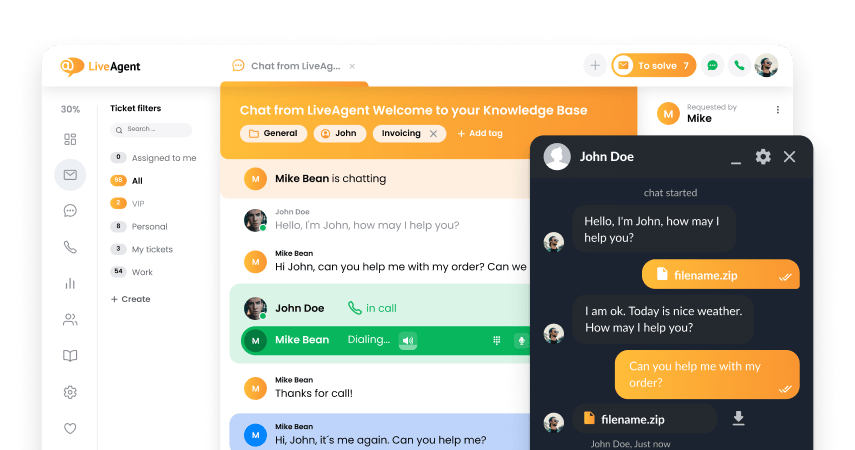one tool
Use social listening with help of LiveAgent.
- ✓ No setup fee
- ✓ Customer service 24/7
Used by

Looking for social listening tools?
If you’re still not using a social listening tool as a part of your marketing and customer support strategy, it’s time to obtain one.
Social listening is all about monitoring what’s being said about your business online. See what your customers think, put your competition in check if they’re bashing you, or answer questions that potential customers might have.
Social listening is a must!
What is social listening?
Social listening, also known as social monitoring, is the process of monitoring digital conversations or online mentions of your brand.
It’s an effective strategy for gathering feedback and monitoring what your customers think of your brand, business, products, or services.
LiveAgent as a social listening tool
LiveAgent connects with all your social media channels and fetches all comments, messages, and mentions of your brand directly into LiveAgent.
Why are social listening tools important to have?
Resolve problems proactively
Social listening tools are great for proactive problem resolution. Acknowledge your frustrated customers before their bad experience goes viral and hurts your business.
Use positive mentions as testimonials
Social listening isn’t just about bad experiences. Showcase the positive things that your customers have to say about your business. There’s nothing like a genuine testimonial!
Gain insight into customer satisfaction
Social listening is a great tool that can give you a general overview of what’s being said about your business online. Monitor what your customers have to say, as well as your competitors.
Easily interact with customers
Answer customer Tweets, Facebook messages, or Instagram comments right from your social listening tool. Don’t waste time logging in and out of different social accounts.

Social listening on Facebook
LiveAgent’s social listening tool streamlines all Facebook messages and comments on your posts and pushes them directly into your LiveAgent dashboard. From there, you can easily respond, like, and even create new posts on your Facebook page.
Social listening on Twitter
Monitor keywords and respond to Tweets mentioning your account. With LiveAgent’s Twitter social listening tool, you’ll never miss a Tweet about your company again.
Simply set up keywords that you want to monitor, and all Tweets containing that keyword will be automatically pushed into your LiveAgent account in the form of a ticket.


Social listening on Instagram
All comments made on your posts or posts that mention your account will be automatically pushed into LiveAgent. Respond directly from LiveAgent without having to look through thousands of notifications on your phone.
LiveAgent organizes all queries according to the importance and time received.
More than just a social listening tool
Ticketing
Streamline all queries from multiple communication channels into a single shared inbox.
Live Chat
Chat with customers and website visitors in real-time. Make use of proactive chat invitations and more.
Support portal
Create stunning customer portals and knowledge bases as self-service solutions for your customers.

LiveAgent combines excellent live chat, ticketing and automation that allow us to provide exceptional support to our customers.
Peter Komornik, CEO
Reasons why companies switch to LiveAgent
Why is LiveAgent the right social listening tool for you?
Most reviewed and #1 rated
LiveAgent has been the most reviewed and #1 rated help desk software for small businesses.
Preferred by 21K businesses
Over 21,000 businesses across various industries have chosen LiveAgent for their customer support needs.
With 180+ features, 40+ integrations and endless customizations, the tool easily adapts to your business requirements.
Cloud-based and secure
Fully cloud-based, secure, easy to set up and use. Get started with LiveAgent in minutes.
Transparent and affordable pricing
Get our professional social listening solution at a fixed monthly price, with no hidden fees or long-term commitments. Sign up for a 30-day free trial to gain full access to all the available features.
What are you waiting for? Start social listening today!
Small business
- Unlimited ticket history
- 3 email addresses
- 3 contact forms
- 1 API key
Medium business
- Everything in Small, plus
- 10 email addresses
- 3 live chat buttons
- Departments management
Most Popular
Large business
- Everything in Medium plus
- 40 email addresses
- 10 live chat buttons
How LiveAgent resolved 75% of chat interactions via the AI Chatbot
Discover how LiveAgent’s AI chatbot resolved 75% of chats, slashed agent workload, and boosted support efficiency. Try LiveAgent now!
Provide excellent customer service
Discover unparalleled customer support with LiveAgent's all-in-one software. Benefit from 24/7 service, a free trial without a credit card, and seamless integration across 130+ ticketing features. Enhance your business with fast setup, AI assistance, live chat, and more. Choose LiveAgent for exceptional service and satisfied customers.
Customer communication management software
LiveAgent customer communication management software will provide personalized, quick, and knowledgeable service to your customers. Try it for free.
You will be
in Good Hands!
Join our community of happy clients and provide excellent customer support with LiveAgent.

Our website uses cookies. By continuing we assume your permission to deploy cookies as detailed in our privacy and cookies policy.

- How to achieve your business goals with LiveAgent
- Tour of the LiveAgent so you can get an idea of how it works
- Answers to any questions you may have about LiveAgent

 Български
Български  Čeština
Čeština  Dansk
Dansk  Deutsch
Deutsch  Eesti
Eesti  Español
Español  Français
Français  Ελληνικα
Ελληνικα  Hrvatski
Hrvatski  Italiano
Italiano  Latviešu
Latviešu  Lietuviškai
Lietuviškai  Magyar
Magyar  Nederlands
Nederlands  Norsk bokmål
Norsk bokmål  Polski
Polski  Română
Română  Русский
Русский  Slovenčina
Slovenčina  Slovenščina
Slovenščina  简体中文
简体中文  Tagalog
Tagalog  Tiếng Việt
Tiếng Việt  العربية
العربية  Português
Português 





